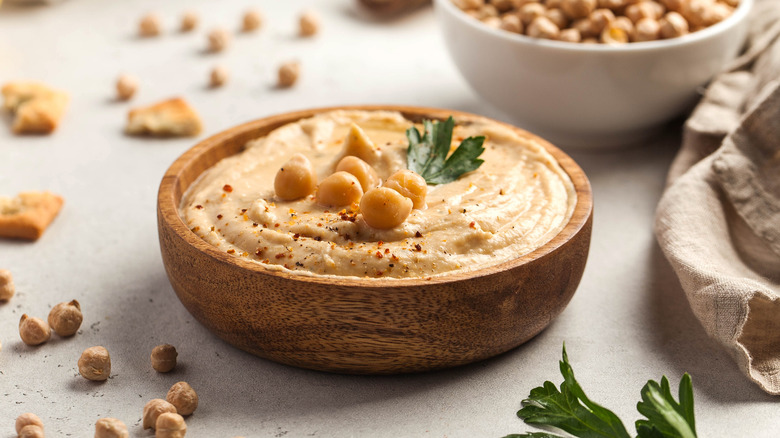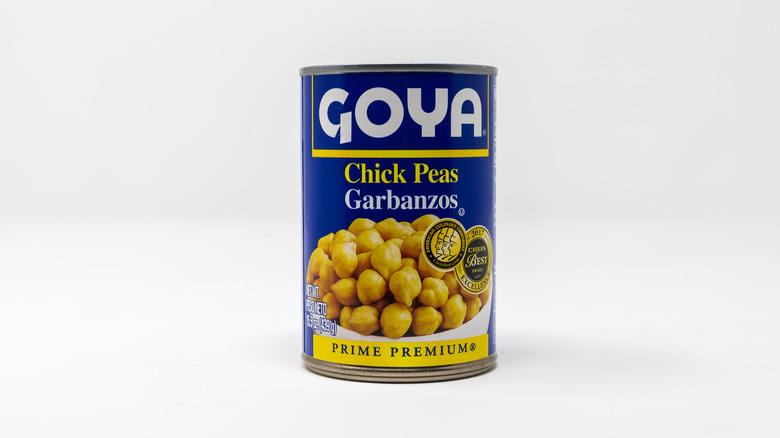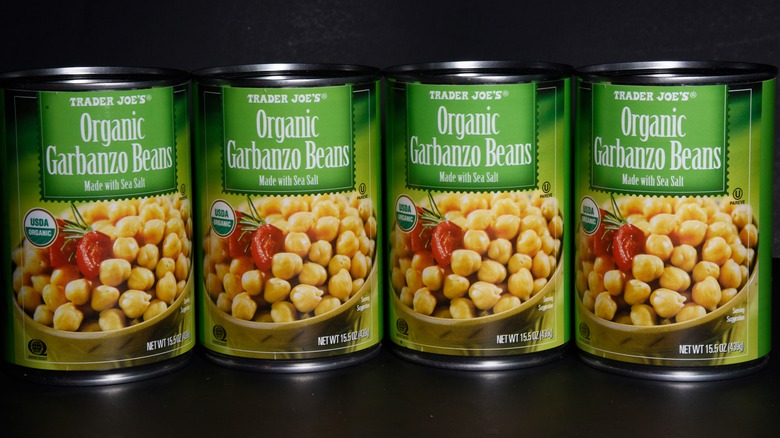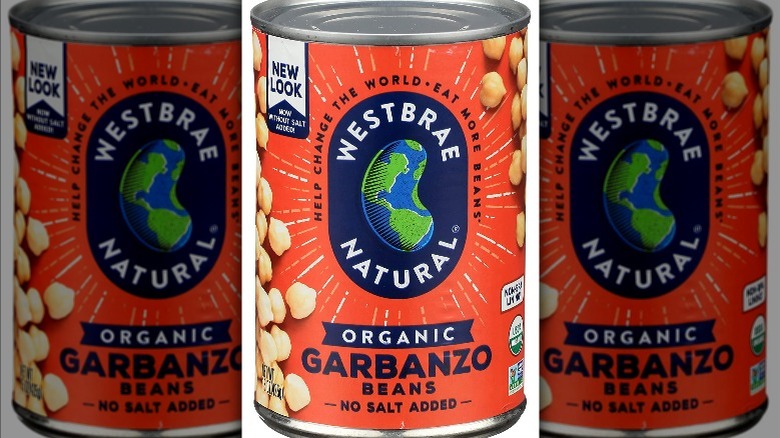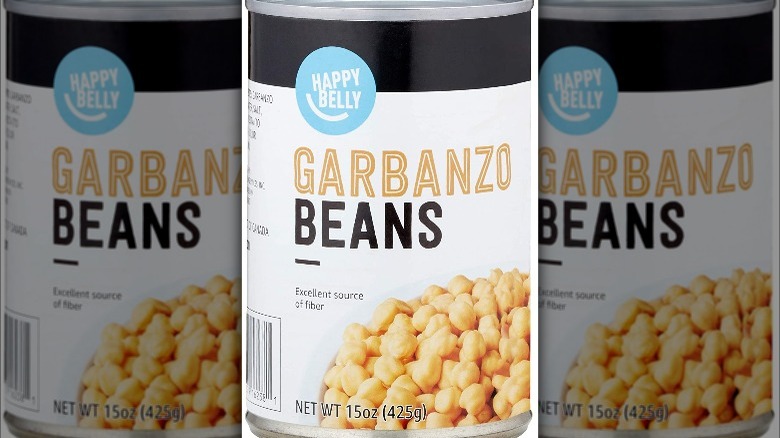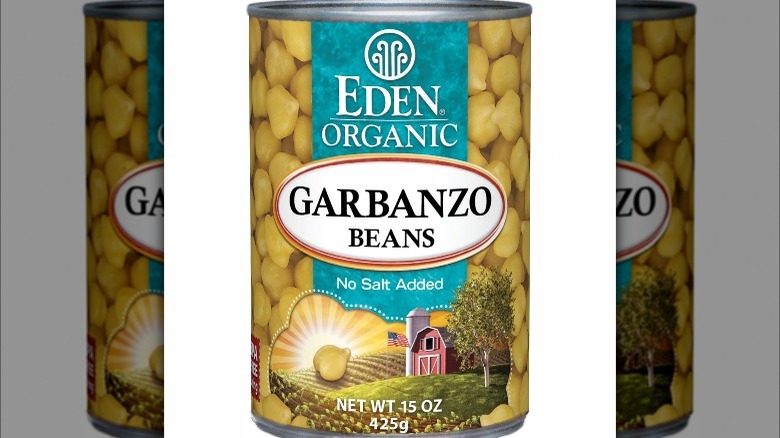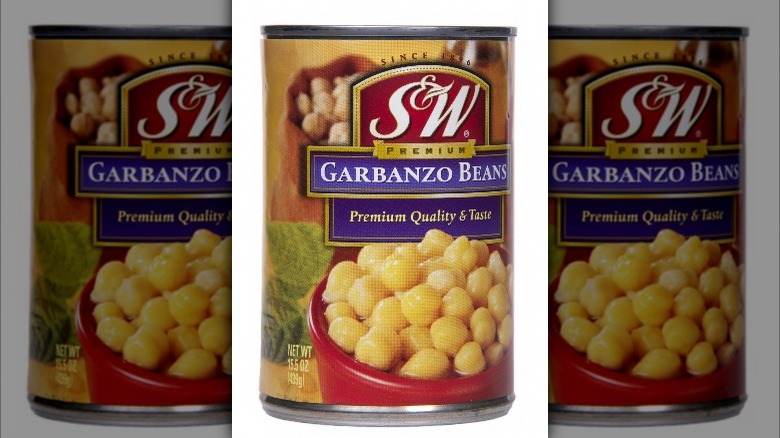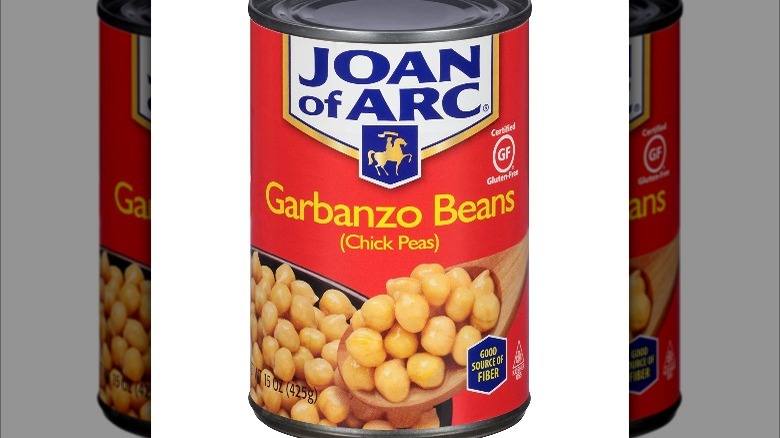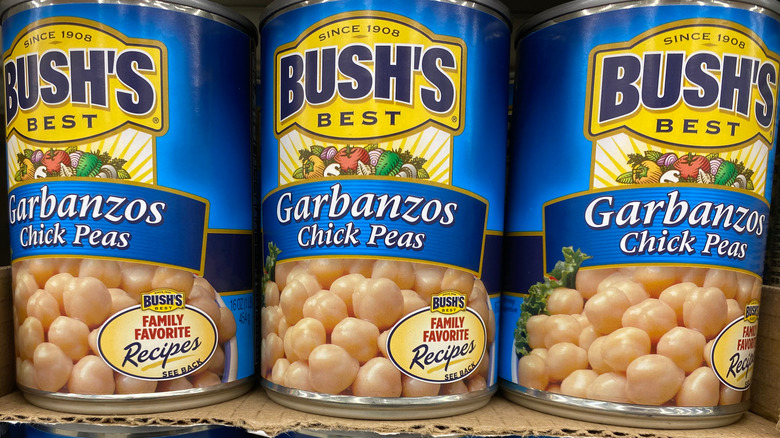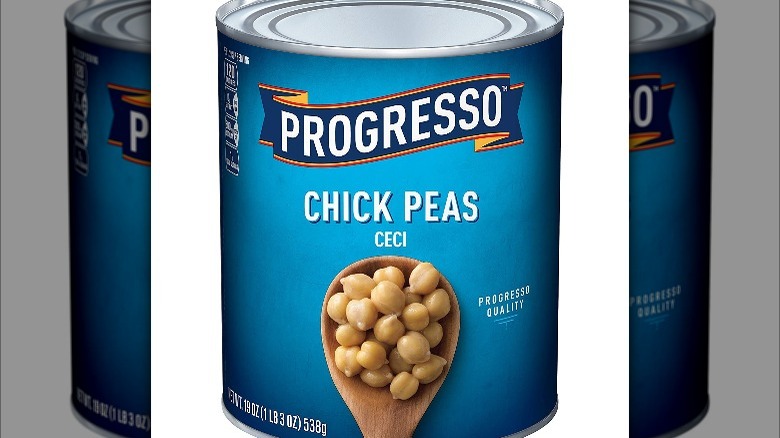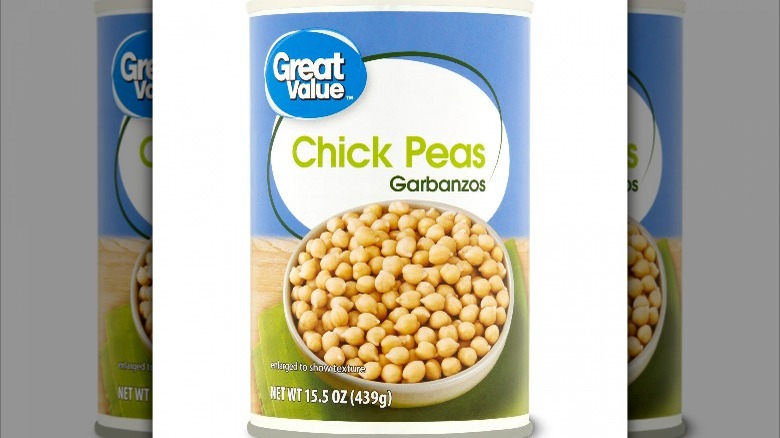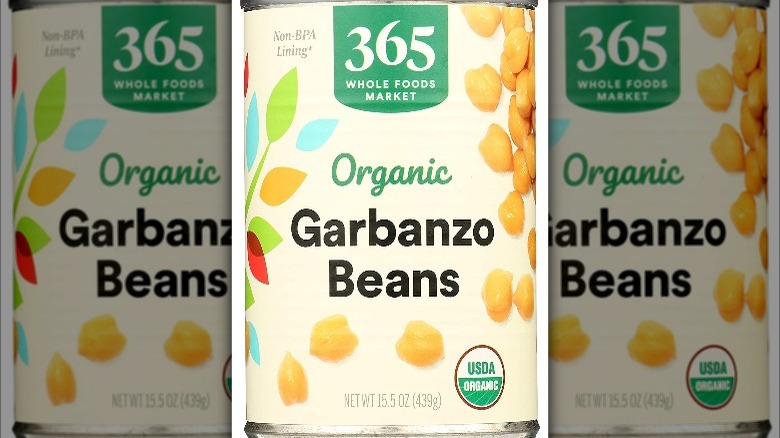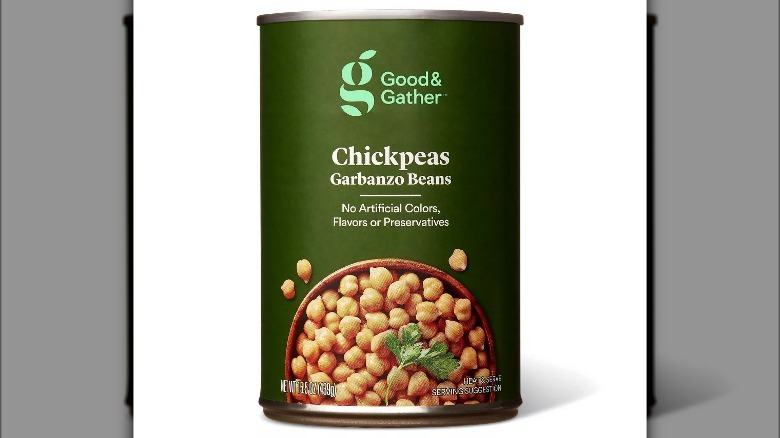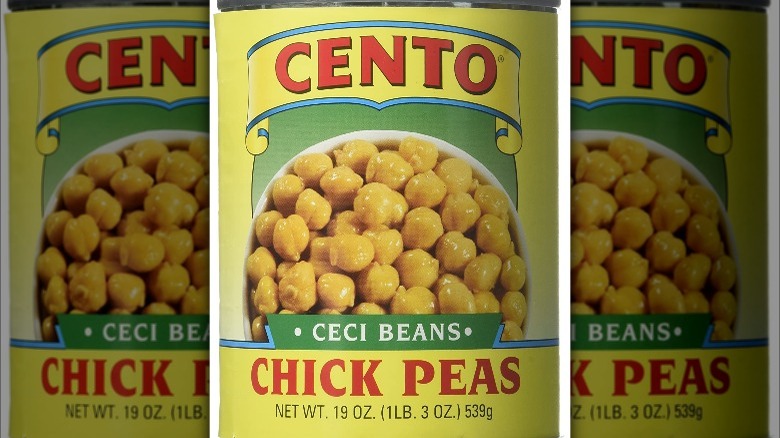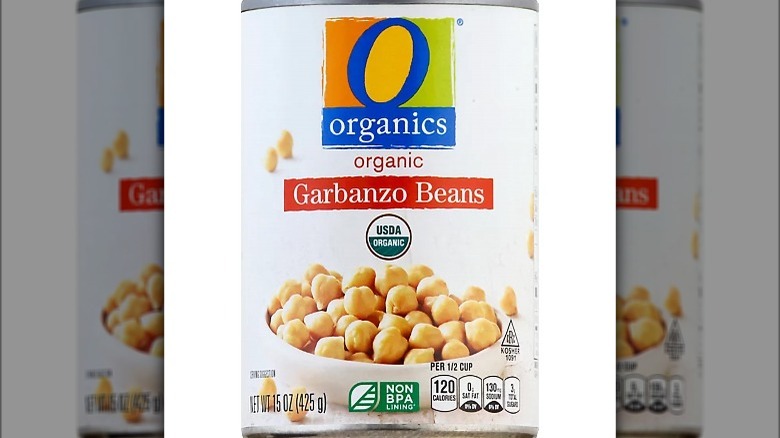7 Canned Chickpea Brands To Buy And 7 To Avoid
We may receive a commission on purchases made from links.
A can of chickpeas — also called garbanzo beans — might seem like a simple item, but in fact, it can be a secret culinary weapon. Hungry for a salty snack but fresh out of chips? Eat your legumes with olive oil, salt, and spices, spread them on a baking sheet, and roast them until they've reached crispy perfection. Looking to give your salad a bit more heft? Sprinkle these beige beauties atop your cucumbers and spinach and make it into a hearty meal. Need something to wow your party guests? With a can of chickpeas, a blender, tahini, lemon juice, and your choice of seasonings, you can easily whip up a delicious, creamy homemade hummus recipe. No wonder chickpeas are a beloved ingredient all over the world — and canning makes them easier to use than ever.
But not all canned chickpeas are created equal. Some brands take on the pantry staple are delicious, fresh, and well-textured, but others offer only slimy piles of congealed chickpea rubble. Moreover, with chickpeas having reached new heights of popularity, there are more options to choose from than ever before. How's a home cook supposed to know which brands to trust? Not to worry — help is on the way. We're here to take a look at the canned chickpea brands you should spend your hard-earned dollars on and the brands you should avoid at all costs.
Buy: Goya
From the moment you peel back the top of the can, Goya's chickpeas are sure to impress you. The first thing you notice is the aroma: These chickpeas smell fresh. There's no metallic odor, as is often the case with canned goods — the scent that hits your nostrils smells purely and simply of garden-grown legumes. As you spoon them out to rinse, cook, or dress, you realize these chickpeas are also uniquely well-textured. Each individual bean is firm, round, and well-shaped. Few Goya chickpeas get squished in the can, and almost none are crumbled altogether. This makes them an excellent choice for salads, as well as for long-simmered stew. No matter the application, they're sure to keep their shape.
But how do they taste? These chickpeas are creamy, flavorful, and mild without being boring. This makes them a wonderful choice for chickpea-centric dishes. One Amazon user summed this up perfectly with a review saying it "makes the best tasting hummus." Subtle flavors of umami, sweetness, and even a slightly floral note make these chickpeas stand out from the rest of the pack, but they don't prevent them from soaking up whatever seasonings you'd like to apply. Goya's chickpeas are uniquely excellent at taking on external flavors. Whether you're making a spicy soup or a smooth hummus, you can't go wrong with these beloved legumes.
Avoid: Trader Joe's
The fact that Trader Joe's canned chickpeas disappoint is surprising, given their delicious souped-up Greek chickpeas. The two offerings shouldn't taste as different as they do: The latter product is just plain old canned chickpeas with some spices, lemon juice, and soybean oil thrown in. But the gulf between them is, somehow, enormous. Trader Joe's non-Greek canned chickpeas almost taste like a different legume altogether.
The biggest problem with these glum garbanzos is texture. When you first pop them into your mouth, you might not notice the issue. These chickpeas appear to be firm, distinctly shaped, and largely intact, no matter how much the can might have rolled around in the back of your pantry. But then you bite down, and the problem becomes all too clear. Though they're firm on the outside, these chickpeas have positively mushy interiors. All too soon, your mouth will be filled with an undifferentiated chickpea paste. This makes for disappointing salads, uneven roasting, and unpleasantly watery hummus. Taste-wise, they're not terrible, but the texture issue is simply too big to ignore. Stick to Trader Joe's Greek chickpeas and leave the plain version on the shelf.
Buy: Westbrae Natural
One bite of Westbrae Natural's canned chickpeas is all you'll need to understand why they're worth your money. These chickpeas are exploding with garbanzo goodness. There's something almost meaty about the flavor of these legumes — even without seasoning, they have a rich, savory taste that lingers long after you've spooned up the final bite. It's a little earthy, a little sweet, and impressively creamy.
Carnivores looking to explore meatless options, take note: With the proper seasoning, these canned chickpeas might just fool you into thinking you're eating something that came from a cow. Their robust texture enhances the effect, though it might be too much for some people. These chickpeas are so well-preserved, they border on crunchy. This makes them an excellent choice for salads, but you might want to build in a little extra simmering time if you're making a stew.
Westbrae Natural's Garbanzo Beans further distinguish themselves by being one of the best low-sodium options on the market. Their no-salt-added garbanzo beans boast just 10 milligrams of sodium per serving. Many low-sodium options taste horribly bland, but these chickpeas are none the worse for their lack of salt. In fact, their delicate flavor comes through a little more strongly. Even if you're not required to keep to a low-salt diet, you might want to check these chickpeas out. Their bright, clear flavor stands up well to whatever experimentation you can dream up.
Avoid: Amazon's Happy Belly
Good beans should taste, well, like beans. This is a surprisingly difficult flavor to describe: It's rich, savory, sweet, and delicate, all at the same time. What's not difficult, however, is describing what they shouldn't taste like. Beans shouldn't taste metallic, soapy, fermented, or grassy. Sadly, too many of these words describe Happy Belly's canned chickpeas. Review after review points out this unpleasant flavor.
One Amazon reviewer hit the nail on the head when they said, "I don't know how to explain it really. If you've ever made dried beans, the taste is similar to if you left it out to soak for too long and it got that weird fermented/almost sprouted bean taste?" This odd taste isn't the only problem with these chickpeas, either: Each can is also disappointingly watery. Another reviewer noted, "After draining the liquid the can was only about ⅔ full of garbanzos, considerably fewer than competitors." Is this the product of oversight, or a ruthless cost-cutting measure? We're not sure, but we do know that skimpy cans of soapy chickpeas aren't worth anyone's hard-earned dollars.
Buy: Eden Organic
Eden Organic's chickpeas are excellent in just about any dish you can imagine, but they're especially spectacular in simply dressed salads. That's because these legumes are straight-up gorgeous. Granted, all of the chickpeas we've deemed buy-worthy emerge from the can well-shaped and tasty. But Eden Organic's need to be seen to be believed: The delicate curves, buttery color, and lustrous surfaces are all perfectly preserved to the point that they look fresh out of the pod. This dazzling first impression is backed up by its superb texture and taste. These chickpeas are smooth without being mushy, firm without being unpleasantly crisp, and earthy without being funky. They are, in short, just about everything a chickpea should be.
These legumes also boast an impressively health-conscious profile. With 50 milligrams of sodium per serving, they're an excellent choice for the salt-conscious among us. The cans are also BPA, BPS, and phthalate free. Home cooks should note, however, that they're cooked with kombu seaweed. Each can claims this is to support excellent texture, taste, and digestion, and we have no complaints. There is no pungent seaweed taste, nor shreds of kombu in the can. But if seaweed disagrees with you, you might want to look elsewhere.
Avoid: S&W
S&W's canned chickpeas are a profoundly mixed bag. Texturally, they're pretty solid: The beans are firm and well-shaped, though not as distinctly as any of our buy picks, yet remain creamy enough to blend into hummus. They're also decidedly tasty. These chickpeas are among the most savory on this list. When eating these legumes, you might not pick up on their subtle sweetness. Those who enjoy that delicate flavor will be disappointed, but eaters in search of the most umami-rich garbanzo bean out there might be intrigued. These are chickpeas that want to complement a hearty dinner or even stand in for something like ground beef.
You might be thinking, at this point, that S&W chickpeas could be a great choice for your vegetarian chili. But here's the thing: That savory quality comes from a whole lot of salt. Each serving boasts a whopping 420 milligrams of sodium. S&W does offer a low-sodium option, but the flavor is incredibly bland — there's no reason to opt for it when superior choices, like Goya or Westbrae Natural's low-salt chickpeas, are available. Even if you don't have to follow a low-salt diet, S&W's chickpeas still aren't a great choice. After the first few bites, the chickpeas' actual flavor becomes hard to discern amongst all that sodium. The first few bites are solid, but the rest are just frustrating.
Buy: Joan of Arc
Chickpeas are the cornerstone of a wide variety of dishes. Some require the cook to grind them up into a smooth paste, some call for roasting at high heat, and some simmer the legumes until they've become deeply infused with external flavors. Even the best chickpeas tend to work better in some preparations than others — yet this is not the case with Joan of Arc's offering. These canned chickpeas are among the most versatile on the market. A quick peek at the Amazon reviews make this clear, as users describe putting them to work in hummus, salads, and even bean-based blondies.
These chickpeas excellence is immediately evident once you crack open a can. They smell wonderfully fresh, suffer little damage, and boast toothsome texture. The flavor is simultaneously rich and subtle, and though each can contains a lot of sodium, they never taste overly salty. While these virtues would already land Joan of Arc's chickpeas on the buy side of this list, they don't quite explain why they're so darn good in such a wide variety of applications. After all, other brands we cover here are similarly fresh-tasting, well-textured, and fragrant — what makes Joan of Arc's garbanzo beans more flexible than they? In all honesty, we don't know. But we do know that this versatility is a delight.
Avoid: Bush's
Chickpeas are mildly flavored, which makes them a great choice for spice-laden dishes like chana masala and pasta e ceci. But you shouldn't mistake such mildness for blandness. When eaten on their own, chickpeas should taste earthy, fresh, vegetal, and faintly sweet. The best canned chickpea brands preserve this complex and subtle interplay of tastes, while the worst smother it in salt. So it goes with Bush's canned chickpeas, which rival the Dead Sea in terms of sheer, shocking salinity.
How salty are we talking about here, exactly? Let's make it plain: Every serving of Bush's canned chickpeas contains a staggering 480 milligrams of sodium. That puts it among the most salt-drenched chickpeas on this entire list. The legumes' actual flavor is completely buried beneath this sodium avalanche. All you can taste is salt, and nothing else makes up for this, either — these chickpeas are no great shakes in terms of texture or ability to absorb seasoning. Even those with a robust salt tooth will find themselves severely tested by these beans.
Buy: Progresso
Are you looking to add more vegetarian dinners to your repertoire? Are you a bit apprehensive about this, given you or your family's carnivorous appetites? Then you need to stock up on Progresso's canned chickpeas, which are among the robust legumes on the market. First off, each individual chickpea is large and firm. No detail is crumbled, smushed, or scraped away in the can — these beans look fresh from the garden. This makes them an excellent candidate for simmering — after an hour or two in the pot, they become potent flavor bombs that still hold their shape — and also ideal for roasting, which turns them into crunchy, flavorful delights as good on salads as they are eaten out of hand.
Progresso's chickpeas really shine when it comes to taste, however. These beans lack some of the sweetness that makes other chickpeas great: Their dominant flavor is, without a doubt, umami. While this makes them a bad choice for, say, dessert hummus, it makes them an excellent entrée. They're earthy to the point of tasting almost meaty, which makes them delicious when paired with smoky spices or bright acids. These are the sort of chickpeas you make into chili, patties, or stew. If you're not looking to substitute meat, they're also a wonderful complement to it, especially chicken and beef. These are chickpeas that will stick to your ribs.
Avoid: Great Value
Great Value's chickpeas get a few things right. Nutritionally, they're impressively balanced, containing lots of fiber and only a moderate amount of sodium. They're also incredibly budget-friendly. But this last quality might be a flaw in disguise — these chickpeas taste seriously and disastrously cheap. Somehow, they're simultaneously bland and gross: There's a lack of real chickpea flavor, and an abundance of something unpleasantly funky. The taste is metallic — which we're chalking up to the can — stale, and musty, like they've been sitting in a damp basement for a long stretch of time. A long cooking period that incorporates a range of pungent spices and some brightening squirts of citrus might disguise this, but why go to the trouble when there are so many better options available?
These chickpeas are also frustrating when it comes to texture. They're oddly hard, rough, and dry, as though they were plucked from their pods too early. Simmering might ameliorate this problem, but it's so pronounced that we're not convinced it'd solve it. Chewing them is kind of like gnawing on birdshot or gravel. And really, not many people are longing for that culinary experience.
Buy: 365 Whole Foods Market
Whole Foods has built its brand on, well, whole foods. Preservatives are kept to a minimum, freshness is prized, and things are kept as natural as possible. These values are never more clear than in the 365 Whole Foods Market canned chickpeas. These legumes are pretty much the platonic ideal of chickpeas. Taste-wise, they're incredibly rich and creamy. Every facet of chickpea flavor is present and in perfect balance with each other, from hearty umami to crisp, vegetal freshness. This brings a wonderful depth and complexity to anything you make with these chickpeas; though they soak up whatever flavors you can throw at them like eager sponges, they don't lose their characteristic taste. They're just as impressive in terms of texture, being delightfully firm right out of the can, yet capable of becoming sublimely soft if that's what your recipe calls for.
These chickpeas become even more impressive when you look at their nutritional facts. Every serving of these lovely legumes clocks in at just 90 milligrams of sodium. These aren't a low-salt variant, either — although Whole Foods Market does offer one, which clocks in at just 10 milligrams per serving. No, these are the brand's standard chickpeas. This lack of salt doesn't diminish their flavor whatsoever; in fact, they taste significantly more vibrant than many of the high-salt chickpeas on this list. They're delicious, versatile, and healthy — in short, everything you could ask for.
Avoid: Target's Good & Gather
Good & Gather's chickpeas are a frustrating patchwork of quality. On the one hand, they taste pretty darn good — rich, a little nutty, and very slightly sweet. This makes them a solid choice for chickpea-forward dishes like hummus. So why are they on the avoid side of our list? It's all down to texture. First off, Good & Gather's chickpeas tend to arrive a little worse for the wear. Compared to other brands, there's a lot more damage done to each individual chickpea: Crumbling is common, fine details are often worn away, and the chickpeas at the bottom of the can tend to get flattened.
Recent cans also seem to skimp on the amount of chickpeas — as one online Target reviewer noted, "As soon as I opened the can, I knew something was off. The chickpeas were only about halfway up the can, rather than 3/4 or mostly full like these cans used to be." We can't be sure, but this roominess seems likely to be the source of these can's damaged chickpeas.
What's worse, this isn't the only textural issue. You'd think these chickpeas would be overly soft, given the issues with crumbliness, but in fact, they're on the unpleasantly hard side of things. Many cans taste like they haven't been cooked all the way through, which completely eliminates the convenience canned foods are meant to offer. The effect is of eating rubble, which pretty much nobody wants from their chickpeas.
Buy: Cento
Cento specializes in Italian food. It's no surprise, then, that its canned chickpeas are an ideal choice for pasta e ceci. But that's not the only dish that suits these luscious legumes — in fact, they're good in just about anything. Cento's chickpeas are hearty, large, and flavorful. They taste incredibly fresh and slightly more vegetal than most chickpeas, which pairs nicely with their crisp texture. This is delicious, refreshing, and makes them a wonderful choice for heavier dishes, to which they bring a welcome note of lightness.
Cento's chickpeas are most dramatically distinguished by the robustness. No matter what you do to them, they retain their appealing flavor, and it takes a lot to get them to soften out of shape. This helps them bring a distinctive note to salads, pastas, and curries. Where lesser chickpeas feel like filler in such dishes, Cento reminds you why they're an essential ingredient. Don't think that means they're a poor choice for intensely seasoned hummus or stew — their unmistakable flavor plays beautifully with pungent ingredients like garlic, scallions, cumin, and oregano. Cento's chickpeas are one-of-a-kind wherever they go, and we couldn't be happier about it.
Avoid: O Organics
Most of the worst chickpeas on this list are obviously offensive. They're too soft, too hard, smell off, or taste musty. In contrast, O Organics' canned chickpeas seem pretty okay. They don't give off any sort of unappealing odor, don't arrive as a congealed mass, and don't go overboard on the salt. But avoiding such pitfalls doesn't equal success — a can of chickpeas needs to actively excel at something to earn a spot on the "buy" side of our list. O Organics' chickpeas simply do not do that. In fact, they don't do much of anything besides exist.
It's hard to describe the taste of these chickpeas, as there really isn't much taste to speak of. After a few spoonfuls, you can detect a very faint earthiness, and a hint of salt. It's not unpleasant, but it's barely there. This makes these chickpeas an awful choice for classic dishes like hummus, which depend on bold chickpea flavor. Texturally, the situation is similar: They're soft enough that they lack the pleasant firmness of better chickpeas, and yet they're also hard enough to resist a pleasant creaminess.
